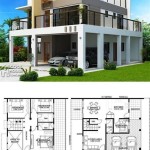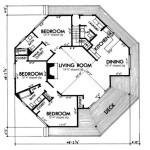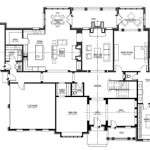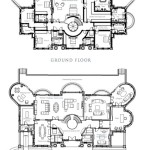Beachfront house floor plans are architectural blueprints that outline the layout and design of a house located on or near a beach. They serve as a visual representation of the home’s interior spaces, exterior features, and overall functionality. For example, a beachfront house floor plan might include details on the number of bedrooms and bathrooms, the kitchen layout, the presence of balconies or patios, and the type of roof or siding.
When designing beachfront house floor plans, architects must consider the unique challenges and opportunities associated with coastal living. Factors such as proximity to the beach, wind and storm resistance, and maximizing natural light and ventilation must be carefully addressed. As a result, beachfront house floor plans often incorporate features such as open floor plans, large windows, and elevated decks to take advantage of the stunning views and coastal environment.
In the following sections, we will explore the essential elements of beachfront house floor plans, discuss the various types of layouts and designs, and provide tips for creating a functional and stylish home that maximizes the beauty and tranquility of beachfront living.
Beachfront house floor plans should prioritize the following key elements:
- Open floor plans
- Large windows
- Elevated decks
- Natural light
- Ventilation
- Storm resistance
- Proximity to beach
- Functional layout
- Stylish design
By incorporating these elements, architects can create beachfront homes that are both beautiful and functional, maximizing the enjoyment of coastal living.
Open floor plans
Open floor plans are a defining characteristic of many beachfront homes. They create a spacious and airy feel, allowing for seamless transitions between different living areas. By eliminating walls and partitions, open floor plans maximize natural light and ventilation, creating a bright and inviting atmosphere.
In beachfront homes, open floor plans often incorporate the living room, dining room, and kitchen into one large, open space. This layout encourages interaction and socialization among family and guests, while also providing unobstructed views of the ocean. Large windows and sliding glass doors further enhance the sense of openness and connection to the outdoors.
Open floor plans also offer flexibility in furniture arrangement and can accommodate a variety of lifestyles. For example, a family with young children might choose to create a play area in the open space, while a couple might prefer to use the space for entertaining guests. The possibilities are endless.
However, it’s important to note that open floor plans are not without their drawbacks. One potential challenge is noise control, as sound can easily travel throughout the open space. Additionally, open floor plans can sometimes lack privacy, especially if there is no designated space for a home office or guest room. Careful planning and design can help to mitigate these challenges and create an open floor plan that is both functional and stylish.
Large windows
Large windows are an essential element of beachfront house floor plans. They offer a number of benefits, including:
- Natural light: Large windows allow for maximum natural light to enter the home, creating a bright and inviting atmosphere. Natural light has been shown to have a number of benefits for human health and well-being, including improved mood, increased productivity, and better sleep.
- Ventilation: Large windows can also help to ventilate the home, allowing fresh air to circulate and reducing the need for artificial ventilation. This is especially important in beachfront homes, which can be prone to moisture and humidity.
- Views: Of course, one of the main reasons to have large windows in a beachfront home is to enjoy the stunning views of the ocean. Large windows frame the oceanfront views and create a sense of connection to the outdoors.
- Architectural interest: Large windows can also add architectural interest to a beachfront home. They can be used to create unique and dramatic effects, such as floor-to-ceiling windows that span the entire height of a room.
When selecting windows for a beachfront home, it is important to consider the following factors:
- Durability: Windows in beachfront homes must be able to withstand the harsh coastal environment, including strong winds, salt spray, and UV radiation. Choose windows that are made of durable materials, such as aluminum or fiberglass, and that have been treated to resist corrosion.
- Energy efficiency: Windows can be a major source of energy loss in a home. Choose energy-efficient windows that are designed to minimize heat loss in the winter and heat gain in the summer.
- Style: The style of the windows should complement the overall design of the home. There are a variety of window styles to choose from, including traditional, contemporary, and coastal.
By carefully selecting and installing large windows, you can create a beachfront home that is both beautiful and functional, maximizing the enjoyment of coastal living.
Elevated decks
Elevated decks are another common feature of beachfront house floor plans. They offer a number of benefits, including:
- Unobstructed views: Elevated decks provide unobstructed views of the ocean, allowing you to enjoy the beauty of your surroundings from the comfort of your own home. They are a great place to relax and unwind, or to entertain guests.
- Outdoor living space: Elevated decks extend the living space of your home outdoors, creating a seamless transition between indoor and outdoor living. They are a great place to dine al fresco, sunbathe, or simply enjoy the fresh air.
- Protection from the elements: Elevated decks provide protection from the elements, such as wind, rain, and sun. They can also help to keep your home cooler in the summer and warmer in the winter.
- Increased property value: Elevated decks can add significant value to your beachfront property. They are a popular feature among buyers, and they can help to increase the resale value of your home.
When designing an elevated deck for your beachfront home, there are a few things to keep in mind:
- Size: The size of your deck will depend on the size of your home and your needs. Consider how you will use the deck and how many people you will need to accommodate.
- Location: The location of your deck is important. Choose a spot that offers the best views and that is protected from the wind. You may also want to consider the orientation of the deck to maximize sun exposure or shade.
- Materials: The materials you use for your deck will depend on your budget and your personal preferences. Popular decking materials include wood, composite, and vinyl.
- Railings: Railings are required for safety on elevated decks. Choose railings that are sturdy and that complement the style of your home.
By carefully planning and designing your elevated deck, you can create a beautiful and functional outdoor space that will add value to your beachfront home and enhance your enjoyment of coastal living.
Natural light
Natural light is an essential element of beachfront house floor plans. It offers a number of benefits, including:
- Improved mood and well-being: Natural light has been shown to have a positive impact on mood and well-being. It can help to reduce stress, improve sleep, and boost energy levels.
- Increased productivity: Natural light can also help to increase productivity. Studies have shown that people who work in naturally lit spaces are more productive than those who work in artificial light.
- Better health: Natural light has also been linked to a number of health benefits, including improved immune function, reduced risk of heart disease, and better bone health.
In beachfront homes, natural light is especially important. The oceanfront views and the abundance of natural light create a sense of peace and tranquility that is unmatched by other types of homes.
There are a number of ways to maximize natural light in beachfront house floor plans. One way is to use large windows and sliding glass doors. These openings allow natural light to flood into the home, creating a bright and inviting atmosphere.
Another way to maximize natural light is to use light-colored finishes. Light-colored walls, floors, and ceilings reflect light, making the space feel larger and brighter. Additionally, using mirrors can help to reflect and distribute natural light throughout the home.
By carefully planning and designing your beachfront home, you can create a space that is filled with natural light. This will not only improve your mood and well-being, but it will also make your home more enjoyable and healthy.
Ventilation
Ventilation is an essential element of beachfront house floor plans. It helps to circulate fresh air throughout the home, removing stale air and moisture. This is especially important in beachfront homes, which can be prone to moisture and humidity.
There are a number of ways to improve ventilation in beachfront house floor plans. One way is to use cross-ventilation. Cross-ventilation is the movement of air through a space from one side to the other. This can be achieved by opening windows and doors on opposite sides of the home.
- Cross-ventilation: Cross-ventilation is the movement of air through a space from one side to the other. This can be achieved by opening windows and doors on opposite sides of the home. Cross-ventilation helps to remove stale air and moisture, and it can also help to cool the home in the summer.
- Natural ventilation: Natural ventilation is the movement of air through a space that is caused by natural forces, such as wind and temperature differences. Natural ventilation can be improved by using operable windows and doors, and by designing the home to take advantage of prevailing winds.
- Mechanical ventilation: Mechanical ventilation is the movement of air through a space that is caused by mechanical means, such as fans and vents. Mechanical ventilation can be used to supplement natural ventilation, or it can be used to provide ventilation in homes that are not well-ventilated naturally.
- Exhaust fans: Exhaust fans are used to remove stale air and moisture from specific areas of the home, such as the kitchen and bathrooms. Exhaust fans can be vented to the outside of the home, or they can be recirculated.
By carefully planning and designing your beachfront home, you can create a space that is well-ventilated and comfortable. This will not only improve your indoor air quality, but it will also make your home more enjoyable and healthy.
Storm resistance
Storm resistance is an important consideration for beachfront house floor plans. Homes in coastal areas are at risk of damage from hurricanes, tropical storms, and other severe weather events. By incorporating storm-resistant features into your home’s design, you can help to protect your family and your property.
- Strong foundation: The foundation of your home is the most important part of its storm resistance. A strong foundation will help to keep your home anchored to the ground and prevent it from being damaged by high winds or flooding.
- Reinforced walls and roof: The walls and roof of your home should be reinforced to withstand high winds. This can be done by using hurricane straps, plywood sheathing, and impact-resistant windows and doors.
- Elevated design: Elevating your home above the ground can help to protect it from flooding. Homes that are built on stilts or raised foundations are less likely to be damaged by storm surge and flooding.
- Flood vents: Flood vents are openings in the foundation of your home that allow water to enter and exit during a flood. This helps to prevent the buildup of hydrostatic pressure, which can cause your home to collapse.
By incorporating these storm-resistant features into your beachfront home’s design, you can help to protect your family and your property from the damaging effects of severe weather.
Proximity to beach
The proximity of a beachfront house to the beach is a key factor to consider when designing the floor plan. The distance from the house to the beach will affect the views, access to the beach, and the overall feel of the home.
Homes that are located directly on the beach have the best views and the most direct access to the sand and water. However, these homes are also more exposed to the elements, such as wind, rain, and salt spray. As a result, they may require more maintenance and repairs.
Homes that are located further from the beach have less direct access to the sand and water, but they are also less exposed to the elements. These homes may have lower maintenance and repair costs, and they may also be more affordable than homes that are located directly on the beach.
When choosing the proximity of your beachfront house to the beach, it is important to consider your lifestyle and needs. If you are looking for a home with stunning views and direct access to the beach, then a home that is located directly on the beach may be the best option for you. However, if you are looking for a home that is more affordable and requires less maintenance, then a home that is located further from the beach may be a better choice.
Functional layout
A functional layout is essential for any home, but it is especially important for beachfront homes. Beachfront homes are often used for vacation rentals, so it is important to create a layout that is both comfortable and convenient for guests.
- Open floor plan: Open floor plans are a popular choice for beachfront homes because they create a spacious and inviting atmosphere. Open floor plans allow for easy flow between different living areas, making it easy for guests to socialize and interact.
- Well-defined spaces: While open floor plans are great for creating a sense of spaciousness, it is also important to have well-defined spaces for different activities. For example, the living room should be separate from the kitchen and dining area, and the bedrooms should be located in a quiet area of the home.
- Plenty of storage: Beachfront homes often have a lot of storage space for beach gear, towels, and other items. When designing your floor plan, be sure to include plenty of closets, cabinets, and shelves to keep your home organized and clutter-free.
- Easy access to outdoor space: Beachfront homes should have easy access to outdoor space, such as a deck or patio. Outdoor space is a great place to relax and enjoy the views, and it can also be used for entertaining guests.
By carefully planning and designing your beachfront home’s floor plan, you can create a space that is both functional and comfortable. This will make your home more enjoyable for both you and your guests.
Stylish design
Stylish design is an important consideration for any home, but it is especially important for beachfront homes. Beachfront homes are often used for vacation rentals, so it is important to create a design that is both stylish and inviting. Here are a few tips for creating a stylish beachfront home:
Use coastal colors and materials: Coastal colors, such as blues, greens, and whites, can help to create a relaxing and inviting atmosphere. Natural materials, such as wood, stone, and glass, can also help to create a coastal feel.
Maximize natural light: Natural light can help to make a home feel more spacious and inviting. Beachfront homes should be designed to maximize natural light by using large windows and sliding glass doors. Skylights can also be used to bring natural light into darker areas of the home.
Create a focal point: Every room should have a focal point, such as a fireplace, a piece of art, or a stunning view. The focal point of a room can help to draw the eye and create a sense of balance.
Accessorize with coastal dcor: Coastal dcor can help to add personality and style to a beachfront home. Items such as seashells, driftwood, and nautical artwork can all help to create a coastal feel.










Related Posts








